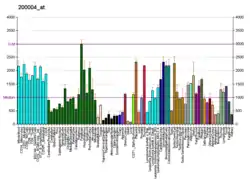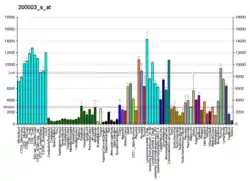PRPF8
Pre-mRNA-processing-splicing factor 8 is a protein that in humans is encoded by the PRPF8 gene.[5][6]
Function
Pre-mRNA splicing occurs in 2 sequential transesterification steps. The protein encoded by this gene is a component of both U2- and U12-dependent spliceosomes, and found to be essential for the catalytic step II in pre-mRNA splicing process. It contains several WD repeats, which function in protein-protein interactions. This protein has a sequence similarity to yeast Prp8 protein. This gene is a candidate gene for autosomal dominant retinitis pigmentosa.[7]
References
- ENSG00000174231 GRCh38: Ensembl release 89: ENSG00000274442, ENSG00000174231 - Ensembl, May 2017
- GRCm38: Ensembl release 89: ENSMUSG00000020850 - Ensembl, May 2017
- "Human PubMed Reference:". National Center for Biotechnology Information, U.S. National Library of Medicine.
- "Mouse PubMed Reference:". National Center for Biotechnology Information, U.S. National Library of Medicine.
- McKie AB, McHale JC, Keen TJ, Tarttelin EE, Goliath R, van Lith-Verhoeven JJ, Greenberg J, Ramesar RS, Hoyng CB, Cremers FP, Mackey DA, Bhattacharya SS, Bird AC, Markham AF, Inglehearn CF (Jul 2001). "Mutations in the pre-mRNA splicing factor gene PRPC8 in autosomal dominant retinitis pigmentosa (RP13)". Human Molecular Genetics. 10 (15): 1555–62. doi:10.1093/hmg/10.15.1555. PMID 11468273.
- Luo HR, Moreau GA, Levin N, Moore MJ (Jul 1999). "The human Prp8 protein is a component of both U2- and U12-dependent spliceosomes". RNA. 5 (7): 893–908. doi:10.1017/S1355838299990520. PMC 1369814. PMID 10411133.
- "Entrez Gene: PRPF8 PRP8 pre-mRNA processing factor 8 homolog (S. cerevisiae)".
- Ewing RM, Chu P, Elisma F, Li H, Taylor P, Climie S, McBroom-Cerajewski L, Robinson MD, O'Connor L, Li M, Taylor R, Dharsee M, Ho Y, Heilbut A, Moore L, Zhang S, Ornatsky O, Bukhman YV, Ethier M, Sheng Y, Vasilescu J, Abu-Farha M, Lambert JP, Duewel HS, Stewart II, Kuehl B, Hogue K, Colwill K, Gladwish K, Muskat B, Kinach R, Adams SL, Moran MF, Morin GB, Topaloglou T, Figeys D (2007). "Large-scale mapping of human protein-protein interactions by mass spectrometry". Molecular Systems Biology. 3 (1): 89. doi:10.1038/msb4100134. PMC 1847948. PMID 17353931.
- Achsel T, Ahrens K, Brahms H, Teigelkamp S, Lührmann R (Nov 1998). "The human U5-220kD protein (hPrp8) forms a stable RNA-free complex with several U5-specific proteins, including an RNA unwindase, a homologue of ribosomal elongation factor EF-2, and a novel WD-40 protein". Molecular and Cellular Biology. 18 (11): 6756–66. doi:10.1128/mcb.18.11.6756. PMC 109259. PMID 9774689.
Further reading
- Grainger RJ, Beggs JD (May 2005). "Prp8 protein: at the heart of the spliceosome". RNA. 11 (5): 533–57. doi:10.1261/rna.2220705. PMC 1370742. PMID 15840809.
- Garcia-Blanco MA, Anderson GJ, Beggs J, Sharp PA (Apr 1990). "A mammalian protein of 220 kDa binds pre-mRNAs in the spliceosome: a potential homologue of the yeast PRP8 protein". Proceedings of the National Academy of Sciences of the United States of America. 87 (8): 3082–6. doi:10.1073/pnas.87.8.3082. PMC 53838. PMID 2139226.
- Pinto AL, Steitz JA (Nov 1989). "The mammalian analogue of the yeast PRP8 splicing protein is present in the U4/5/6 small nuclear ribonucleoprotein particle and the spliceosome". Proceedings of the National Academy of Sciences of the United States of America. 86 (22): 8742–6. doi:10.1073/pnas.86.22.8742. PMC 298364. PMID 2479028.
- Bach M, Winkelmann G, Lührmann R (Aug 1989). "20S small nuclear ribonucleoprotein U5 shows a surprisingly complex protein composition". Proceedings of the National Academy of Sciences of the United States of America. 86 (16): 6038–42. doi:10.1073/pnas.86.16.6038. PMC 297770. PMID 2527369.
- Anderson GJ, Bach M, Lührmann R, Beggs JD (Dec 1989). "Conservation between yeast and man of a protein associated with U5 small nuclear ribonucleoprotein". Nature. 342 (6251): 819–21. doi:10.1038/342819a0. PMID 2532307. S2CID 977768.
- Umen JG, Guthrie C (Aug 1995). "Prp16p, Slu7p, and Prp8p interact with the 3' splice site in two distinct stages during the second catalytic step of pre-mRNA splicing". RNA. 1 (6): 584–97. PMC 1369303. PMID 7489518.
- Goliath R, Shugart Y, Janssens P, Weissenbach J, Beighton P, Ramasar R, Greenberg J (Oct 1995). "Fine localization of the locus for autosomal dominant retinitis pigmentosa on chromosome 17p". American Journal of Human Genetics. 57 (4): 962–5. PMC 1801525. PMID 7573060.
- Greenberg J, Goliath R, Beighton P, Ramesar R (Jun 1994). "A new locus for autosomal dominant retinitis pigmentosa on the short arm of chromosome 17". Human Molecular Genetics. 3 (6): 915–8. doi:10.1093/hmg/3.6.915. PMID 7951236.
- Maruyama K, Sugano S (Jan 1994). "Oligo-capping: a simple method to replace the cap structure of eukaryotic mRNAs with oligoribonucleotides". Gene. 138 (1–2): 171–4. doi:10.1016/0378-1119(94)90802-8. PMID 8125298.
- Kojis TL, Heinzmann C, Flodman P, Ngo JT, Sparkes RS, Spence MA, Bateman JB, Heckenlively JR (Feb 1996). "Map refinement of locus RP13 to human chromosome 17p13.3 in a second family with autosomal dominant retinitis pigmentosa". American Journal of Human Genetics. 58 (2): 347–55. PMC 1914553. PMID 8571961.
- Reyes JL, Kois P, Konforti BB, Konarska MM (Mar 1996). "The canonical GU dinucleotide at the 5' splice site is recognized by p220 of the U5 snRNP within the spliceosome". RNA. 2 (3): 213–25. PMC 1369364. PMID 8608445.
- Hinz M, Moore MJ, Bindereif A (Aug 1996). "Domain analysis of human U5 RNA. Cap trimethylation, protein binding, and spliceosome assembly". The Journal of Biological Chemistry. 271 (31): 19001–7. doi:10.1074/jbc.271.31.19001. PMID 8702566.
- Chiara MD, Palandjian L, Feld Kramer R, Reed R (Aug 1997). "Evidence that U5 snRNP recognizes the 3' splice site for catalytic step II in mammals". The EMBO Journal. 16 (15): 4746–59. doi:10.1093/emboj/16.15.4746. PMC 1170101. PMID 9303319.
- Suzuki Y, Yoshitomo-Nakagawa K, Maruyama K, Suyama A, Sugano S (Oct 1997). "Construction and characterization of a full length-enriched and a 5'-end-enriched cDNA library". Gene. 200 (1–2): 149–56. doi:10.1016/S0378-1119(97)00411-3. PMID 9373149.
- Achsel T, Ahrens K, Brahms H, Teigelkamp S, Lührmann R (Nov 1998). "The human U5-220kD protein (hPrp8) forms a stable RNA-free complex with several U5-specific proteins, including an RNA unwindase, a homologue of ribosomal elongation factor EF-2, and a novel WD-40 protein". Molecular and Cellular Biology. 18 (11): 6756–66. doi:10.1128/mcb.18.11.6756. PMC 109259. PMID 9774689.
- Reyes JL, Gustafson EH, Luo HR, Moore MJ, Konarska MM (Feb 1999). "The C-terminal region of hPrp8 interacts with the conserved GU dinucleotide at the 5' splice site". RNA. 5 (2): 167–79. doi:10.1017/S1355838299981785. PMC 1369749. PMID 10024169.
- Makarov EM, Makarova OV, Achsel T, Lührmann R (May 2000). "The human homologue of the yeast splicing factor prp6p contains multiple TPR elements and is stably associated with the U5 snRNP via protein-protein interactions". Journal of Molecular Biology. 298 (4): 567–75. doi:10.1006/jmbi.2000.3685. PMID 10788320.
- Le Hir H, Moore MJ, Maquat LE (May 2000). "Pre-mRNA splicing alters mRNP composition: evidence for stable association of proteins at exon-exon junctions". Genes & Development. 14 (9): 1098–108. PMC 316578. PMID 10809668.
- McHale JC, McKie AB, Tarttelin EE, Inglehearn CF (2000). "Expression map of human chromosome region 17p13.3, spanning the RP13 dominant retinitis pigmentosa locus, the Miller-Dieker lissencephaly syndrome (MDLS) region, and a putative tumour suppressor locus". Cytogenetics and Cell Genetics. 88 (3–4): 225–9. doi:10.1159/000015556. PMID 10828595. S2CID 46632974.
This article is issued from Wikipedia. The text is licensed under Creative Commons - Attribution - Sharealike. Additional terms may apply for the media files.







